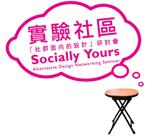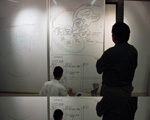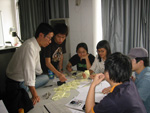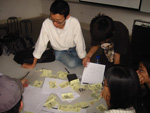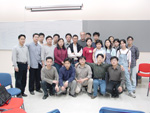|
Day Two: From Cultural Research to Design Benny
Leong Presentation Benny Leong chose to enter the discussion from the point of view of an industrial practitioner and educator. Through reviewing the macro picture of the industry in the recent decades, Leong explained why social issues became a concern of design. Leong also shared of his experiences, in order to illustrate the specific methodology needed for this kind of research-based design. Through reviewing the general tendency of the global economy, Leong illustrated that a transition is taking place in the world economy today. Now both the design industry and design education institute have to take the issue of sustainability ( no matter social or environmental one) into account. A social learning process has to be initiated by design to enable this systemic shift toward sustainability. The goal of design is also undergoing the transition from P to C: from Preference to Compulsory. Yet Leong pointed out that, rather than being a threat, this drastic alteration offers industries the opportunity to innovate. And design has been evolved to anticipate this alteration based on a very different set of strategy. Leong shared some of the methods and tools he is currently adopting. The first of all is the device to involve local users in the design process. So generally Leong and his group would conduct a series of workshops for the users to participate in the brainstorming and discussion of the initial ideas. This is very important for the solutions to be compatible with the local context. Leong stressed that to make the solution locally appreciated and acceptable is crucial in the process. Leong and his team have also conducted researches on some of the original local solutions. Once the initial idea is generated, designers should then start to draft the initial system of the solution, and also to translate it into visual language. User experience design and scenario visualization should then be following up. At the latter stage, for the solution to be actually executed, a more detailed design of the product-service system has then to be designed. This again has to be translated into visual language, so as to facilitate the communication between different stakeholders. Visual communication works such as posters or mood boards directed to the public are also needed before the solution actually goes into the market. These methods and tools illustrate perfectly how social issues could be handled by the lead of design. Leong at last emphasized that this model should only be taken as an example, every solution and implementation should be cultural context-specific.
Biography Benny Leong (of School of Design, Hong Kong Polytechnic University, Hong Kong Leong returned to Hong Kong in 1994 and start his teaching career in the School of Design (SD) at Hong Kong Polytechnic University. He is now an Assistant Professor, deputy discipline leader of Industrial & Product Design, and leader of the Asian Lifestyle Design Research Lab in SD. Leong's research focuses on the revitalization of Chinese culture in sustainable design and contemporary design thinking and practice. He is involved with various international organizations on sustainable design, including Chinese Network on Design for Sustainability in China, International Promotional Group of Design for Sustainability (DfS); O2 Global-Net, and is a co-author of "Design Vision: a Sustainable way of Living in China". |
| X Close | |
